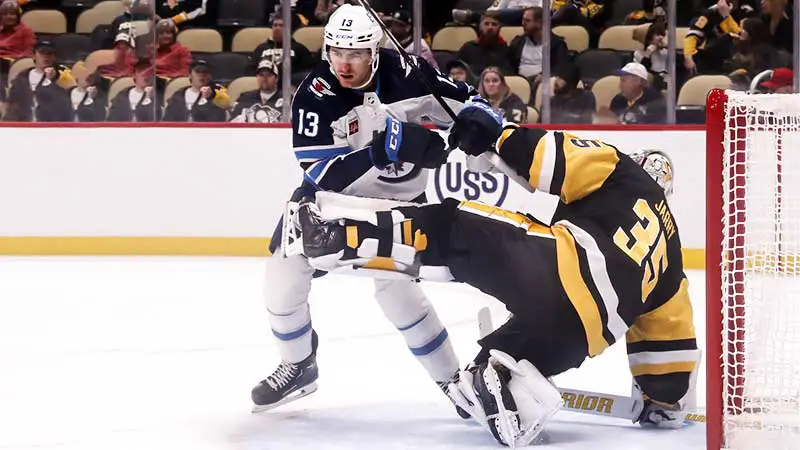Ever wondered why you never see a hockey goalie in the penalty box? Despite their crucial role and frequent involvement in the game’s rough and tumble, goalies can and do get penalties.
However, the rules of ice hockey dictate that when a goalie is penalized, they don’t serve the penalty themselves.
Instead, a player chosen by the coach serves the time in the penalty box. This unique rule keeps the game flowing and ensures that the team isn’t left defenseless.
Goalies can be penalized for a variety of infractions, from slashing and high-sticking to more specific offenses like intentionally freezing the puck outside the crease.
So next time you see a goalie getting a bit too aggressive, remember, their penalty minutes might be adding up, even if they’re not the ones sitting out.
Goalie Penalties in Hockey
In hockey, goalie penalties are a bit different from those incurred by other players. Goalies can receive penalties for various infractions, but the consequences are often more significant because a goalie cannot be replaced on the ice by another player if they’re serving a penalty.
Here are some common penalties that goalies might receive:
Types of Penalties
Goalies can commit various types of penalties akin to field players. Minor penalties like tripping or high-sticking result in a player serving two minutes on behalf of the goalie.
Major penalties such as deliberate injury attempts bring significant consequences, including a five-minute penalty and potential additional disciplinary actions.
Goalies must also adhere to specific rules to avoid infractions like playing the puck in restricted zones or intentionally delaying the game by freezing the puck outside the crease.
How Penalties Differ from Player Penalties
When a goalie gets penalized, the key difference is that they don’t serve the time themselves. Instead, a player on the ice at the time of the infraction serves the penalty.
This rule ensures that the team isn’t left without a goalie, maintaining the game’s flow and integrity. Unlike player penalties, which directly affect the skater’s participation, goalie penalties impact the team’s overall strategy and often lead to bench minor penalties if the offending player is the coach.
Common Reasons Goalies Receive Penalties
Goalies in hockey can receive penalties for various infractions, although their actions are typically more limited than those of skaters.
Here are some common reasons why goalies might receive penalties:
Delay Of Game
Delay of game infractions often occur when a goalie intentionally disrupts the flow of play. Common examples include shooting the puck out of play from their defensive zone, holding the puck for longer than permitted, or engaging in a pattern of repeatedly refusing to send players out for faceoffs.
Since the 2005-06 NHL season, goalies are penalized for playing the puck outside the designated trapezoid area behind the net.
A delay of game penalty usually results in a minor penalty, causing your team to play short-handed for two minutes.
Puck Handling Violations
Goalies face restrictions regarding where they can handle the puck on the ice. The trapezoid rule, implemented post the 2004-05 AHL season, confines goalies to a specific area behind the goal line when playing the puck.
Handling the puck outside this zone leads to a minor penalty. Additionally, goalies can incur penalties for playing the puck with their blocker, stick, or glove in a manner deemed dangerous or unfair, such as deliberately throwing their stick or any other object to disrupt play.
Goalie Interference
Although commonly associated with skaters, goalies can also be penalized for interference. For example, a goalie may use their body, stick, or equipment to interfere with opponents in an illegal manner.
This includes deliberate attempts to impede an opponent’s movement or using violent actions like elbowing or kicking.
Interference penalties result in your team having to play short-handed, usually for two minutes, and can escalate to more severe penalties if the actions cause injury or are repetitive.
Process When a Goalie Gets a Penalty
When a goalie receives a penalty in hockey, the process typically involves the following steps:
Who Serves the Penalty
When a goalie gets a penalty, another player serves it on their behalf. According to Rule 407(a), the player serving must be on the ice when the infraction occurred.
Let’s say a goalie receives a minor penalty for slashing. A player on the ice at that time serves the minor penalty in the penalty box.
This designated player serves to ensure that the goalie remains in the game while still enforcing the penalty.
Team’s Response and Strategy
The team’s response to a goalie penalty involves strategic adjustments to maintain competitive advantage. If the penalty is a two-minute minor, the team plays short-handed for two minutes.
The coach must select a player who was on the ice when the infraction occurred to serve the penalty. While this player is in the penalty box, the team must defend against the opposing team’s power play.
If the goalie receives a major or game misconduct penalty, the team must manage additional complexities. In the case of a game misconduct, the goalie is sent to the dressing room, and a backup goalie takes their place.
The player serving the misconduct penalty is allowed to return to the game immediately upon penalty expiration. These strategies help ensure the team remains competitive, even when dealing with goalie penalties.
Impact of Goalie Penalties on the Game
Goalie penalties in hockey can have a significant impact on the game, often influencing the momentum and outcome in various ways:
Short-Term Impacts during the Game
When a goalie gets a penalty in ice hockey, immediate strategic adjustments become necessary. Since the goalie doesn’t serve penalties, a skater from the ice at the time of the infraction will enter the penalty box. This decision impacts the team’s dynamics, as they’ll temporarily lose a skater.
Time spent short-handed can disrupt defensive strategies, leading to increased pressure on the remaining players. They must cover more ice and protect the goal more vigilantly.
For instance, if a defenseman serves the penalty, the team might find themselves more vulnerable to offensive plays by the opposition due to the loss of a key defensive player.
The goalie’s absence from direct penalty responsibility means the coach must choose a substitute tactically.
Choosing a less critical skater might seem ideal, but it’s always a balancing act to ensure team cohesion and effectiveness remain intact during the penalty.
Long-Term Effects on Team Dynamics
Penalties assigned to a goalie also influence longer-term team dynamics. If a goalie repeatedly incurs penalties, it reflects on both the individual and team discipline.
Chronic infractions can lead to the team reevaluating goalie training, with particular emphasis on reducing behaviors that result in penalties.
Morale might also be affected. Consistent disruptions due to goalie penalties can strain player relationships.
Teammates may feel additional pressure or frustration if they’re frequently asked to serve penalties on behalf of the goalie, which might influence performance and overall harmony.
In severe cases involving game misconduct or major penalties, the impact becomes more pronounced. The backup goalie entering the game changes the team’s dynamics, affecting strategy and potentially altering the game’s outcome.
Such situations underscore the importance of goalie discipline and adherence to rules, both for immediate gameplay and sustained team success.
Frequently Asked Questions
Can a backup goalie serve a bench minor penalty?
No, a goaltender cannot go to the penalty box. Instead, another player who was on the ice at the time of the infraction must serve the penalty on behalf of the goalie.
What penalties can goalies get?
Goalies can incur penalties such as interference if they participate beyond the center red line or throwing penalties if they drop-kick the puck. These actions are penalized under specific rules laid out in the sport.
How does a 10-minute misconduct work in hockey?
A 10-minute misconduct penalty requires the offending player to spend 10 minutes in the penalty box. However, the team does not play short-handed; another player substitutes in to keep the team at full strength on the ice.
What happens if a goalie is pulled?
A pulled goalie can return to the ice if the substitution rules are followed. This often happens strategically towards the end of a game to increase offensive chances.
Can a goalie take a penalty?
Yes, goalies can take penalties. When this happens, another player serves the time in the penalty box, while the penalty is still charged to the goalie’s record.
Conclusion
Understanding what happens when a hockey goalie gets a penalty is crucial for grasping the game’s strategic depth. The unique rule where another player serves the penalty underscores the need for quick strategic adjustments.
This situation not only tests the team’s immediate defensive capabilities but also highlights the importance of maintaining discipline to avoid long-term disruptions.
By focusing on goalie training and discipline, you can help ensure that your team remains cohesive and competitive, even when faced with the complexities of goalie penalties.
Teams often rely on a designated skater to serve the penalty, usually one less critical to immediate play. The goalie remains in net, ensuring the team’s backbone stays intact while adapting their strategy.








James Felix